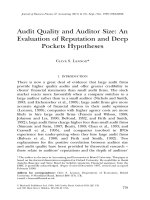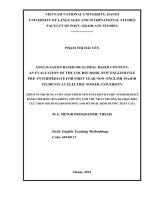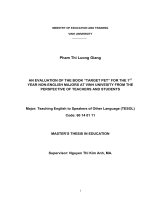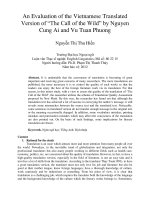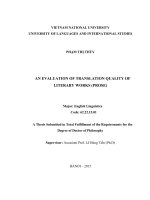AN EVALUATION OF CUSTOMER SATISFACTION OF VIETCOMBANK’S CARD SERVICES
Bạn đang xem bản rút gọn của tài liệu. Xem và tải ngay bản đầy đủ của tài liệu tại đây (592.86 KB, 101 trang )
INTERNATIONAL EXECUTIVE MASTER OF BUSINESS
ADMINISTRATION
AN EVALUATION OF CUSTOMER SATISFACTION
OF VIETCOMBANK’S CARD SERVICES
Nguyen Thi Thuy Hang
ID: VN1001992
Class: IEMBA.SBF05
November 2021
Nguyen Thi Thuy Hang – IEMBA - Intake 05
DISSERTATION DECLARATION FORM
I declare that this dissertation has been submitted neither to another
master's program nor to any degree-issuing program. All my dissertation
citations have been properly acknowledged in the dissertation references.
Further, I warrant that I have solely conducted the dissertation and in
completing my dissertation, I have applied knowledge gained from the
academic programs.
I am fully aware that any breach of the above is considered as plagiarism
and can lead to the dismissal of my dissertation for consideration in the
degree program.
Student’s Signature
1
Nguyen Thi Thuy Hang – IEMBA - Intake 05
ACKNOWLEDGEMENT
First, I would like to express my sincere thanks for lecturers joining the
International Executive Master of Business Administration – Paris Graduate
School of Management (PGSM). Those have conveyed my knowledge
during my study so that I have necessary knowledge and skills to
implement this thesis.
In particular, I would like to express my deep gratitude to Dr. Luong Thai
Bao – my advisor for generous guidance, enthusiasm, devotion and time,
helped me gradually to develop my research skill and inspired me to do the
best at every stage of the research process.
Secondly, I would like to thank the Leaders and staffs of Vietcombank who
have fully supported me in providing valuable input information and all
students of IEMBA – intake 5 who encourage me complete the course.
Finally, I also would like to express my warm thanks for people who have
heartedly supported me during the course.
Thanks and best regards,
Author
Nguyen Thi Thuy Hang
2
TABLE OF CONTENTS
DISSERTATION DECLARATION FORM..........................................................................i
TABLE OF CONTENTS....................................................................................................iii
ACKNOWLEDGEMENT.....................................................................................................ii
LIST OF TABLES AND CHARTS.........................................................................................vii
CHAPTER 1: INTRODUCTION.........................................................................................1
1.1.
Rationale................................................................................................................. 1
1.2.
Research Objectives...............................................................................................3
1.3.
Research Questions................................................................................................3
With the above research objectives, the study will focus on answering some of
the following questions:........................................................................................................3
1.4.
Research Scope.......................................................................................................3
1.5.
Method of the Research.........................................................................................4
1.6.
Limitation of the Study..........................................................................................5
1.7.
Thesis Structure.....................................................................................................5
CHAPTER 2: CONCEPTUAL FRAMEWORK OF THE STUDY......................................7
2.1.
2.1.1.
Terms and Concepts..............................................................................................7
Bank Card............................................................................................................7
Features of Bank Card.........................................................................................................7
Bank Card Classification.....................................................................................................8
2.1.2.
Card Service.......................................................................................................10
Entities Involved in Card Service Activities.....................................................................11
Role of Bank Card Service.................................................................................................12
2.1.3.
Card Service Quality..........................................................................................14
Service Quality.................................................................................................................... 14
Card Service Quality..........................................................................................................14
Criteria for Evaluating Service Quality of Card Services...............................................15
Factors Affecting Card Services Quality..........................................................................18
2.2.
Literature Review of Bank Card Service Quality.............................................20
2.2.1.
Foreign Studies..................................................................................................20
2.2.2.
Local Studies......................................................................................................21
2.3.
Conceptual Model of Service Quality.................................................................22
2.3.1.
Introduction of SERQUAL Model.....................................................................22
2.3.2.
Model of the Thesis............................................................................................28
CHAPTER 3. VIETCOMBANK CARD BUSINSESS PERFORMANCE........................30
3.1.
Over View of Vietcombank..................................................................................30
3.1.1.
History of Development and Organizational Structure.......................................30
3.1.2.
Business Result of Vietcombankin recent years.................................................32
3.2.
Current Status of Vietcombank’s Card Service................................................34
3.2.1.
Establishment and Development of Card Operation..........................................34
3.2.2.
Card Issuing Activities.......................................................................................37
3.2.3.
Card Acquiring Activities...................................................................................45
3.2.4.
Network Developing Activities..........................................................................49
CHAPTER 4. DATA ANALYSIS AND FINDINGS...........................................................53
4.1.
Research Process..................................................................................................53
Survey Process.................................................................................................................... 53
4.2.
Empirical Result..................................................................................................55
4.2.1.
Description of the study sample.........................................................................55
4.2.2.
Test Cronbach's Alpha scale...............................................................................56
4.2.3.
Exploratory Factor Analysis (EFA)....................................................................60
4.2.4.
Regression analysis............................................................................................64
4.3.
4.3.1.
Evaluating the Quality of Card Services at Vietcombank................................66
From Survey.......................................................................................................66
CHAPTER 5: RECOMMENDATIONS TO IMPROVE THE QUALITY OF
CARD SERVICES AT VIETCOMBANK...........................................................................72
5.1.
Development orientation of card service quality at Vietcombank...................72
5.2.
Recommendation to improve card services quality at Vietcombank...............73
Recommendations on responsiveness................................................................................74
Recommendation on reliability.........................................................................................74
Recommendation on 3 other groups of factors.................................................................75
CONCLUSION...................................................................................................................77
REFERENCES.......................................................................................................79Annex 1
............................................................................................................................................. 83
TABLE OF ABBREVIATIONS
Amex
American Express
ATM
Automated Teller Machine
POS
Point of Sale
EMV
Europay Master Visa
Joint Stock Commercial Bank for
VCB, Vietcombank
Foreign Trade of Vietnam
LIST OF TABLES AND CHARTS
1. Figure
Figure 2.1: Serqual Model.....................................................................................24
Figure 2.2: Theoretical framework.......................................................................29
Figure 3.3: Number of VCB international credit card issue in 2017-2020..........40
Figure 3.4: VCB international credit card spending volume in 2017-2020.........41
Figure 3.5: Market Share of VCB international debit card issue number in 20182020........................................................................................................................42
Figure 3.6: VCB international debit card spending volume in 2017-2020...........43
Figure 3.7: Number of VCB Connect24 card issue in 2017-2020........................44
Figure 3.8: Market Share of VCB domestic debit card spending volume in 20182020........................................................................................................................45
Figure 3.9: International card acquiring revenue of VCB in 2017-2020.............47
Figure 3.10: Market Share of domestic card acquiring turnover in 2018-2020...49
Figure 3.11: Market Share of ATM number of VCB in 2018-2020......................50
Figure 3.12: POS number of Vietcombank...........................................................51
2. Table
Table 3.1: Business Result from 2017-2020..........................................................33
Table 3.2: Result of service activity........................................................................33
CHAPTER 1: INTRODUCTION
This study focuses on the application of customer satisfaction model to card
services of Joint Stock Commercial Bank for Foreign Trade of Vietnam
(Vietcombank). The theoretical model has been published by Parasuraman in 1988,
and provides five factors that directly affect customer satisfaction in service
industries. The model has been tested and applied to a number of companies around
the world. The model will be applied to evaluate satisfaction of customer for
Vietcombank’s card services. The bank was established in 1963 in Hanoi, offering
financial services to customers. It currently has nearly 600 branches/transaction
offices/representative offices/members at home and abroad with over 20,000
employees.
This chapter gives an overview of the rationale for the study and the objective and
the research question. It also provides an overview of the methodology, and the
scope, limitation, and organization of the study.
1.1.
Rationale
In the era of industrial revolution 4.0, along with the explosion of non-cash payment
means, the card service business has the potential to bring more and more revenue
and profit to banks. Revenue from card issuance and payment activities can be
considered as a long-term, stable and potentially less risky source of income than
others.
If in the previous period, many Vietnamese commercial banks had to concentrate
strong financial resources and experience in exploiting card-related services. The
development of smart mobile phones along with the Internet, artificial intelligence...
is making the appearance of a number of new forms and means of payment such as
electronic money, mobile money, QR code payment, technology organizations. The
participation of finance and telecommunications in the supply chain of financial
products and services will create more competition and motivation for traditional
card payments. In the race to issue cards and develop payment services, customers
have more and more choices than before, and customers are the decisive factor in
the existence of the bank. Therefore, in order to increase competitiveness, the
assurance and improvement of card service quality must be done regularly by
banks.
The card market share is mainly in the hands of the "big guys" such as
Vietcombank, BIDV, Vietinbank, etc. Fees from cards such as annual fees, cash
withdrawal fees, overdue debt penalties… bring a great source of revenue and
stable profit for banks. Therefore, in the past few years, small banks, foreign banks
and even domestic financial companies and foreign financial institutions have
competed fiercely to quickly grab credit card market share.
Always a pioneer in providing customers with the most optimal financial solutions,
Vietcombank is the first commercial bank in Vietnam to deploy card services with
domestic debit card payment since 1993 and international credit card issuance in
1996. However, in 2020, most of the indicators on card services decreased
compared to 2019, specifically as follows: Card acquiring revenue was 139,460
billion dongs, down 16% compared to 2019; Card spending volume were 39,168
billion dongs, down 15% compared to 2019; The number of new debit connect24
issued in 2020 down 12.6% compared to 2019; The number of merchants in 2020 is
37,596, down 21.9% compared to 2019. Therefore, to take the advantage of being a
leading bank in the field of international payment, maintain and expand the
payment market share in the present fierce competition. Moreover, Vietcombank’s
vision is to become 1st bank of Vietnam in 2030 and strategic goal up to 2025 is No
1 in retail. In order to achieve these goals, Vietcombank not only needs to get back
lost market share in card services but also needs to focus on how to give customers
the best card service quality to satisfy the needs of using cards of the current
customers as well as attract new ones, because quality plays a very important role in
stimulating customer acceptance of banking services.
Stemming from the need to study the above issue, and as a person working at
Vietcombank, the author decided to study the topic "Evaluation of Customer
Satisfaction of Vietcombank's Card Services" to understand the current situation
and give recommendations to improve the quality of card services, contributing to
maintaining, developing and increasing the bank's competitiveness.
1.2.
Research Objectives
With the goal of studying card service quality through building a research model,
testing hypotheses and assessing the perceived level of customers about card service
quality, thereby offering recommendations to improve the quality of card services.
To improve the quality of card services at Vietcombank, the research project is
responsible for dealing the following basic issues:
- Systematize theoretical issues about cards and service quality of commercial bank
cards.
- Analyze the current situation and measure the quality of card services at
Vietcombank to determine the level of impact of the components on the quality of
card services.
- Propose recommendations to improve the quality of card services at Vietcombank.
1.3.
Research Questions
With the above research objectives, the study will focus on answering some of the
following questions:
+ What factors affect the quality of a commercial bank's card services?
+ What is VCB’s current card services performance?
+ How does each factor affect the quality of Vietcombank's card services?
+ What recommendations should be taken to improve the quality of card services at
Vietcombank in order to constantly bring satisfaction to customers?
1.4.
Research Scope
- The object of the study is the customers who are using card services at
Vietcombank and their satisfaction.
- The scope of research is card business from 2017 - 2020 and Vietcombank's
business strategy in the coming years.
1.5.
Method of the Research
This is an empirical study, involving design of survey question, collection of data,
statistical processing of data, analysis of data, and interpretation of the findings.
Research Process
The study is conducted through 2 phases:
- Phase 1, qualitative research: to build and develop a system of concepts,
measurement scales and research variables from which to build survey
questionnaires.
- Phase 2, using SERVQUAL model to measure customer satisfaction with card
service quality at Vietcombank. Conduct quantitative research by surveying,
collecting information, analyzing data, estimating and testing research models
through techniques: descriptive statistics, scale testing (Cronbach Alpha),
exploratory factor analysis (EFA), estimation and testing of multiple regression
models and other analyzes with the support of SPSS software.
Data colection will be done as belowed:
+ Secondary data: will be gathered in four years from 2017 - 2020 via the bank’s
financial report and annual report, data of Card Association, internet, and
magazines, information obtained by the researcher.
+ Primary data: will be conducted in September and October 2021 and be collected
from the evaluation of customer satisfaction of Vietcombank’s card services basing
on specific criteria. The data will help Vietcombank understand its pros and cons to
improve card services quality. Author plans to carry In-depth interview and Survey
to collect information.
(i) In-depth interview: The in-depth interview will be conducted with people
working in card divisions. Through these interviews, Author may get the idea of the
interviewees about the current situation of card services quality of commercial
banks and Vietcombank specifically, and ways to improve Vietcombank’s card
services quality.
(ii) Survey: The survey will be based on 5 dimensions of evaluation of service
quality - SERVQUAL model to measure Vietcombank’s card services quality at
Vietcombank. The survey will be conducted with 150 customers using
Vietcombank’s card services. Questionnaire will have 2 parts, in which part 1 is the
general information of customers and part 2 is about the evaluation of customers on
Vietcombank’s card services quality. Questions will be designed basing on 5
dimensions assessing Vietcombank’s card services quality. In order to have the
detailed assessment, each dimension is divided into smaller factors making
customers easier to answer questions. Questionnaire will be distributed to customers
via email/Google form.
1.6.
Limitation of the Study
Due to the disadvantages of the SERQUAL model used for the research topic. In
addition to the lengthy questionnaire, the concept of expectations was confusing for
respondents. Therefore, using SERVQUAL scale may affect the quality of collected
data, leading to reduced reliability and instability of observed variables.
1.7.
Thesis Structure
The thesis consists of 5 chapters:
Chapter 1 gives some introductory information including the rationale for the study
and the objective and the research question. An overview of the methodology is also
given and key limitations of the study are outlined.
Chapter 2 presents an overview of card service quality at commercial banks
including introduction of bank cards and card services of commercial banks and the
research model of service quality at commercial bank.
Chapter 3 mentions the current status of card service quality at Vietcombank. Here,
an overview of Vietcombank, present status of Vietcombank’s card service will be
addressed.
Chapter 4 gives an analysis on card service quality at Vietcombank basing on the
result of survey.
Chapter 5 addresses orientation to develop card service quality at Vietcombank and
recommendations to improve the quality of card services at Vietcombank.
Conclusion
CHAPTER 2: CONCEPTUAL FRAMEWORK OF THE STUDY
This chapter gives the terms and concepts of bank card, card service and service
quality, review on literature as well as the conceptual model of the study.
2.1.
Terms and Concepts
2.1.1. Bank Card
Bank card is one of the bank's products and services, which is understood as a noncash payment method, born from the retail purchase and sale method and developed
in association with the application of technology in the banking and finance sector.
Bank cards are used to make payments through banks in addition to other means of
payment such as cash, checks, payment orders, and collection orders. Bank cards
have been and are being used popularly around the world.
Features of Bank Card
A regular bank card is designed as a plastic piece with a standard size of 8.5*5.5cm
and has a magnetic stripe on the back that stores encrypted information according to
a unified standard about cardholders such as: card number, expiration date, other
safety check factors; cards with electronic chips to store information and data to
increase security.
On the front of the card, there is usually the name and logo of the card issuer, the
card number, the effective date, the name of the cardholder, the logo of the
international card organization such as Visa, Master, JCB, etc. The back of the card
is usually set up. The design includes a magnetic stripe, a signature strip to store the
customer's signature, in addition to some other information such as customer care
phone number, the bank's website so that the cardholder can contact the card in
necessary situation.
In addition to the normal physical card (plastic card), in the world today, there is a
non-physical card (virtual card) that the issuer grants to the cardholder for
transactions on the internet, mobile phones with Design information similar to
physical cards.
Bank Card Classification
On the market, there are many different types of cards issued by different card
organizations with diverse characteristics and uses. Cards can be classified
according to the following criteria:
Classified by scope of use:
- Domestic card: is a card issued by a card issuer in Vietnam for transactions within
the territory of Vietnam.
- International card: is a card issued by an issuer in Vietnam for transactions within
and outside the territory of Vietnam, or a card issued by a foreign organization for
transactions within the territory of Vietnam. International cards are used to pay for
goods and services at card-accepting units and use other services in Vietnam Dong,
freely convertible foreign currencies and other currencies accepted by card-paying
organizations. as payment currency inside and outside Vietnam.
Classified by financial source to ensure the use of the card:
- Debit card: is a card that allows the cardholder to transact within the amount on
the payment account. To use this card, the cardholder must have a payment account
opened at a payment service provider authorized to receive demand deposits. This
card type when withdrawing money at automatic teller machines (ATMs) or making
purchases at card-accepting units, usually the transaction value will be immediately
deducted from the cardholder's account and transferred immediately into the
accounts of the merchants that accept the cards.
Debit cards have two basic types: Online debit cards when spending, the value of
transactions will be deducted immediately from the cardholder's account; The
offline debit card will deduct expenses from the cardholder's account a few days
later.
- Credit card: is a type of card that allows the cardholder to spend first and pay later,
the card issuer will grant the cardholder a specified credit limit without paying
interest (if the cardholder pays the money used on time). The time limit for the
cardholder to pay the amount spent depends on each type of credit card of different
card organizations, during this time the cardholder is completely exempt from
interest on the arising amount. If at the end of this period, the entire amount due has
not been refunded to the bank, the cardholder will bear the late payment fees and
incurred interest. Credit cards are cyclical in nature, which means that after the
arising amount is paid, the cardholder's credit limit will be restored.
Banks or financial companies issue credit cards to customers based on the
creditworthiness and ability of each customer to pay. The ability to guarantee
payment is determined based on the aggregate of many personal information such
as income, spending situation, available debts, social status, ... of the customer.
Therefore, each customer has different suitable credit limits.
- Prepaid card: is a type of card that allows the cardholder to conduct card
transactions within the value of money loaded into the card corresponding to the
amount prepaid to the card issuer. Prepaid cards include: identity prepaid cards
(with cardholder identification information) and anonymous prepaid cards (without
cardholder identification information).
Classified according to physical properties:
- A physical card is a card that has a physical existence made of plastic or other
materials, with a magnetic stripe or electronic chip strip attached to store card data.
- Non-physical card is a card that does not exist in physical form but still contains
information on the card, issued by the card issuer to the cardholder for transactions
via electronic channels or other card-accepting devices.
Classified by card issuer:
- Personal card is a card that is proposed by an individual in his/her name to be
issued for his/her own use. Personal card includes main card and supplementary
card. An individual is only allowed to issue one main card for each card product and
up to three supplementary cards in accordance with current laws and regulations of
the bank from time to time.
- Company card is a card proposed by a legal entity to be issued in the name of
members of the company to serve the company's expenses. Company card only has
main card, no supplementary card. The Company will be responsible for payment of
all transactions and fees arising from the corporate cards and reserves the right to
make inquiries regarding the use of the card.
Thus, although there are many ways of classifying cards, the above cards all have
one thing in common: they are used to pay for goods and services without using
cash, which brings many benefits to cardholders as well as substantial profits for
card issuers.
2.1.2. Card Service
According to Philip Kotler, a service is an activity consisting of non-existent
elements that resolves the relationship between the customer or the property owned
by the customer and the supplier without the transfer of ownership.
Service is the process of operating activities and behaviors based on intangible
factors to solve the relationships between enterprises and customers. It is a process
that takes place in a certain sequence that includes many different stages, in each
phase there will sometimes be many additional services. Services are associated
with the benefits and values that customers receive after using the service.
Bank card service is a type of service that belongs to the group of retail services of a
modern bank. The bank will provide a payment tool that is a payment card for
customers to use convenient features to meet the needs of non-cash payment. The
bank card service includes all the support the bank creates to fulfill the customer's
request regarding this card.
Entities Involved in Card Service Activities
Card service activities include issuing, using and paying for bank cards, this activity
has the close participation of 4 subjects: card issuers, card acquiring banks,
cardholders and merchants. Each entity plays an important role in maximizing the
role of card services as a modern means of payment.
- Issuing bank: is the bank that performs such tasks as assessing the legality and
financial capacity of customers; issue cards to qualified customers; create and send
statements to cardholders for settlement. In addition, the card issuing bank also has
the right to enter into an agency contract with a third party, which is a bank or other
credit institution in the issuance of credit cards. In order to serve card issuance, card
issuers have to invest a lot in equipment and modern technology platforms such as
card printing system, system of management and data updating related to
cardholders. and spending situation of cardholders... Therefore, in order to become
a card issuer, in addition to prestige, banks and credit institutions in general must
meet certain requirements in terms of financial capacity, investment in technology
and brainpower.
- Acquiring bank: is a bank that accepts cards as a means of payment through
signing a contract to accept cards with points of supply of goods and services. The
acquiring bank will provide these units with automatic card readers with instruction
manual or staff training program on how to operate and accompanying maintenance
service during the operation period. Normally, banks accept cards from merchants
that have contracted to accept cards with a discounted fee for processing
transactions using the card for payment.
- Cardholder: is the individual or person authorized to use the card (company card)
issued by the bank, whose name is printed on the card and uses the card according
to the terms of the contract signed between the two parties. The cardholder includes
the main cardholder and the supplementary cardholder, all spending in the same
card account, the supplementary cardholder is also responsible for paying the
expenses incurred in the period, but the cardholder is the one responsible for the
final payment with the bank.
- Merchant: are goods and service suppliers that sign a contract to accept cards as a
means of payment with banks. To become a merchant with each type of bank card,
they must have good financial position and have business capacity with regular and
stable revenue. Card payment banks will only decide to sign acceptance contracts
with effective business units capable of attracting many card-based payment
transactions. Despite having to pay the paying bank a discount to the amount of
each transaction, merchants still have a competitive advantage because accepting
card payments helps attractting more customers, increase the number of
transactions, reduce cash management costs, thereby improving business efficiency.
Role of Bank Card Service
For macro perspective:
As a non-cash payment instrument, payment cards have a great role and
significance for the economy. The card service will help attract people's demand
deposits into the banking system, reduce the volume of cash in circulation, thereby
contributing to reducing the cost of issuing banknotes, transporting, storing or
destroying moneydue to insufficient standards to be circulated. In addition, the
State and banks can control all transaction activities of any cardholder, creating a
foundation to strengthen the management of personal and corporate income tax
collection.
Bank cards are also used as a stimulus tool. Commercial banks encourage customers
to issue cards by minimizing issuance approval criteria, applying low card spending
interest rates, and coordinating with goods and service providers to have incentive
programs when using the card for customers…
For micro perspective:
- Commercial banks:
Developing card services helps banks increase revenue thanks to fees and interest
earned through card issuance and payment activities. Through this activity,
commercial banks can both entice and attract customers to use cards issued by their
banks, and keep them becoming loyal customers, using more products and services
of the bank.
In addition, if a bank's card service meets the needs of customers, it will contribute
to building the reputation of that bank in the financial market. Reputation is very
important in currency trading. Reputation is the basis for establishing, maintaining
and developing all relationships, especially in the banking sector. The bank can
expand its relationships with partners through the service of issuing linked cards…
This contributes significantly to deciding the bank's competitiveness in the current
market.
- Customers:
The implementation of card services by banks helps customers have access to a
modern form of payment, with many incentives and conveniences, suitable for the
development of society. With the use of credit cards, customers have been granted a
credit limit by the bank to pay for goods and services, helping to improve payment
ability. Moreover, the card service also helps cardholders manage and control their
spending transactions more easily through a flexible and easy-to-understand card
statement system.
- Merchants:
The approval of card payment will help businesses attract customers, especially
foreign tourists, increase sales of goods and services, thereby increasing business
profits. In addition, payment via card will help ensure the payment of customers
because the value of goods is paid through the card issuing bank, saving time in
debt collection from customers, increasing the turnover of capital.
Merchant are a bank's partner, so they will enjoy incentives in credit and loan
activities such as low interest rates, simpler and more convenient lending
procedures...
2.1.3. Card Service Quality
Service Quality
Services play an increasingly important role in creating value to contribute to the
national economy. Realizing the importance of services, academic researchers have
focused on this field since the early 1990s. In the service industry, products are
intangible, their quality assessment is quite difficult.
Service quality is a concept that has attracted the most attention and controversy in
the research papers because researchers face many difficulties in defining and
measuring service quality without any consensus.
Service quality is defined in different ways depending on the object of study and the
research environment. Service quality is the extent to which a service meets the
needs and expectations of customers (Lewis and Mitchell, 1990); Asuboteng and
partners, 1996; Wisniewski and Donnelly, 1996). Edvardsson, Thomsson and
Ovretveit (1994) argue that service quality is a service that meets customers'
expectations and satisfies their needs. According to Parasuraman and partners
(1985, 1988), service quality is the gap between customers' expectations and their
perceptions when using the service.
Card Service Quality
Card services quality is the ability to meet the expectations of card using customers,
in other words, it is all the activities and additional benefits that the bank brings to
customers in order to establish, strengthen and expand long-term partnerships with
customers through creating customer satisfaction. Thus, to assess the quality of a
bank's card service, we rely on customer satisfaction about that service.
Criteria for Evaluating Service Quality of Card Services
For banks, as card service providers to customers, the measurement of card service
quality assists the bank in identifying the current level of service quality, setting
priorities for quality improvement competitively. Not only that, but it also assists
the bank in comparing the status of operational performance between different
points in time, contributing to the assessment of operational efficiency.
Measuring card service quality is also the initial and ongoing basis in the bank's
competitive strategic planning process, all activities revolve around a central goal in
order to shorten the gap between expectations and customers' perception of the
service quality provided by the bank.
Basically, the quality of banking services is reflected through the following two
criteria:
- First: Customer satisfaction about service quality. In the thesis, author will mainly
focus on evaluating card services quality based on SERVQUAL.
There are different views on customer satisfaction. According to Oliver (1997),
Bachelet (1995) argues that customer satisfaction is an emotional response of
customers in response to their experience with a product or service. Kotler and
Keller (2006) define satisfaction as the degree of a person's sensory state resulting
from a comparison of the perception of a product with the person's expectations.
Accordingly, satisfaction has three levels as follows:
+ If the customer's perception is smaller than the expectation, the customer is not
satisfied.
+ If perceived by expectations, customers feel satisfied.
+ If the perception is greater than the expectation, the customer perceives it as
satisfied or delighted
Thus, customer satisfaction on card service quality is the customer's perception of
the bank after using the card service. According to some researchers, it is possible to
classify customer satisfaction using cards into three categories and they have
different impacts on banks:
Positive Satisfaction: This is positive satisfaction and is reflected in the
increasing demand for cards for the bank. For customers with positive satisfaction,
they and the bank will have a good relationship, trust each other and feel satisfied
when doing transactions. Moreover, they also hope that the bank will be able to
meet their increasing demand. Therefore, this is a group of customers who are easy
to become loyal customers of the bank as long as they realize that the bank also has
many improvements in providing services to them. The positive factor is also
reflected in the fact that it is from the constantly increasing requirements of
customers that the bank makes efforts to improve the quality of card services to
become more and more perfect.
Stable satisfaction: For customers with stable satisfaction, they will feel
comfortable and satisfied with the current quality of card services and do not want
to have a change in the way the bank provides services. Therefore, these customers
are pleasant, have high trust in the bank and are willing to continue using the bank's
card services.
Passive satisfaction: Customers with passive satisfaction have little trust in
the bank and they think it is difficult for the bank to improve the quality of card
services and change according to their requirements. They feel satisfied not because
the bank completely satisfied their needs but because they think that it will not be
possible to ask the bank to improve further. Therefore, they will not actively
contribute ideas or appear indifferent to the bank's improvement efforts.
The relationship between quality and customer satisfaction has been a topic of
constant discussion by researchers over the past decades. Many studies on customer
satisfaction in service industries have been carried out and in general conclude that
service quality and satisfaction are two distinct concepts. Customer satisfaction is a
general concept that speaks of their satisfaction when consuming a service, while
service quality is concerned with specific components of the service (Zeithaml and
Bitner, 2000).
Many practical studies on the relationship between service quality and customer
satisfaction. Cronin and Taylor (1992) tested this relationship and concluded that
perceived service quality leads to customer satisfaction. Studies have concluded that
service quality is an antecedent of satisfaction (Cronin and Taylor, 1992; Spreng and
Mackoy, 1996) and a major factor affecting satisfaction (Ruyter, Bloemer, Peeters,
1997).
- Second: The size and proportion of income from the bank's services:
The biggest benefit that banking services bring to commercial banks is profit, or in
other words the service cannot be considered developed if it does not bring actual
profit to the bank. It is difficult to develop a quantitative indicator to measure the
total profit that banking services contribute to the bank's income because there are
services that only cross support wholesale activities, create capital source for
wholesale activities, enhancing the prestige and position of the bank. Specific
incomes that can be assessed from banking services are: Card issuance and payment
fees, payment, consulting, money transfer fees and other fees... These are the
combined results of service diversity, service development and, of course, increased
service quality of the bank. However, the quality of service is more outstanding.
Because if service quality is not guaranteed, not improved, then the diversity of
services and development of services will not make sense because they are not
accepted by customers, so the scale and proportion of income from services of the
bank can’t be increased.
In addition, commercial banks can consider the number of customers and market
share as criteria for evaluating service quality. Although this indicator does not
directly reflect service quality, without good banking service quality, it is not
possible to have a good number of customers and a good market share. Attracting as
many customers as possible is very important.



